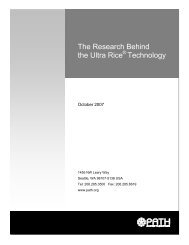Guidelines on stock records for immunization programme - Path
Guidelines on stock records for immunization programme - Path
Guidelines on stock records for immunization programme - Path
Create successful ePaper yourself
Turn your PDF publications into a flip-book with our unique Google optimized e-Paper software.
Issue voucher:<br />
Issues data:<br />
Lead time:<br />
Losses:<br />
Maximum <strong>stock</strong> level:<br />
Min/max:<br />
Minimum <strong>stock</strong> level:<br />
Packing slip:<br />
Physical inventory:<br />
Pull system:<br />
Push system:<br />
Quantity in hand:<br />
Transacti<strong>on</strong> record that lists the items and<br />
quantities of products issued to a facility.<br />
In<strong>for</strong>mati<strong>on</strong> <strong>on</strong> the quantity of goods shipped<br />
from <strong>on</strong>e level of a system to another. See also<br />
c<strong>on</strong>sumpti<strong>on</strong> data.<br />
The time between when new <strong>stock</strong> is ordered<br />
and when it is received and available <strong>for</strong> use.<br />
Lead time varies, depending <strong>on</strong> the system,<br />
speed of deliveries, availability and reliability of<br />
transport, and sometimes, weather.<br />
The quantity of <strong>stock</strong> removed from the pipeline<br />
<strong>for</strong> any reas<strong>on</strong> other than c<strong>on</strong>sumpti<strong>on</strong> by clients<br />
(e.g., expirati<strong>on</strong> and damage).<br />
The largest amount of <strong>stock</strong> the <strong>programme</strong><br />
should have in <strong>stock</strong>, usually expressed as the<br />
number of m<strong>on</strong>ths of supply. It is the minimum<br />
<strong>stock</strong> plus that amount of <strong>stock</strong> used between<br />
orders.<br />
Assigned minimum and maximum <strong>stock</strong> levels<br />
designed to ensure that a <strong>programme</strong> does not<br />
run out of immunizati<strong>on</strong> supplies and also does<br />
not become over<strong>stock</strong>ed.<br />
The least amount of <strong>stock</strong> that <strong>programme</strong>s<br />
should have in <strong>stock</strong> or the level which,<br />
when reached, initiates a reorder;<br />
usually expressed as the number of m<strong>on</strong>ths of<br />
supply. It is the amount of <strong>stock</strong> used between<br />
placing and receiving an order plus the safety<br />
<strong>stock</strong>. Also known as “reorder level”.<br />
Transacti<strong>on</strong> record sent with products that lists<br />
the names and quantities of each product shipped.<br />
Usually paired with a receiving record.<br />
A count of all the commodities <strong>on</strong> <strong>stock</strong> to verify<br />
that the amount that is actually stored is the same<br />
as the quantity listed in the <strong>stock</strong>-keeping<br />
<strong>records</strong>.<br />
A distributi<strong>on</strong> system in which the pers<strong>on</strong>nel who<br />
receive the supplies determine the quantities to<br />
order. Also called as “requisiti<strong>on</strong>” system.<br />
A distributi<strong>on</strong> system in which the pers<strong>on</strong>nel who<br />
issue the supplies determine the quantities to be<br />
issued. Also called as “allocati<strong>on</strong>” system.<br />
The quantity of usable <strong>stock</strong> in inventory at a<br />
particular point in time.<br />
x

















